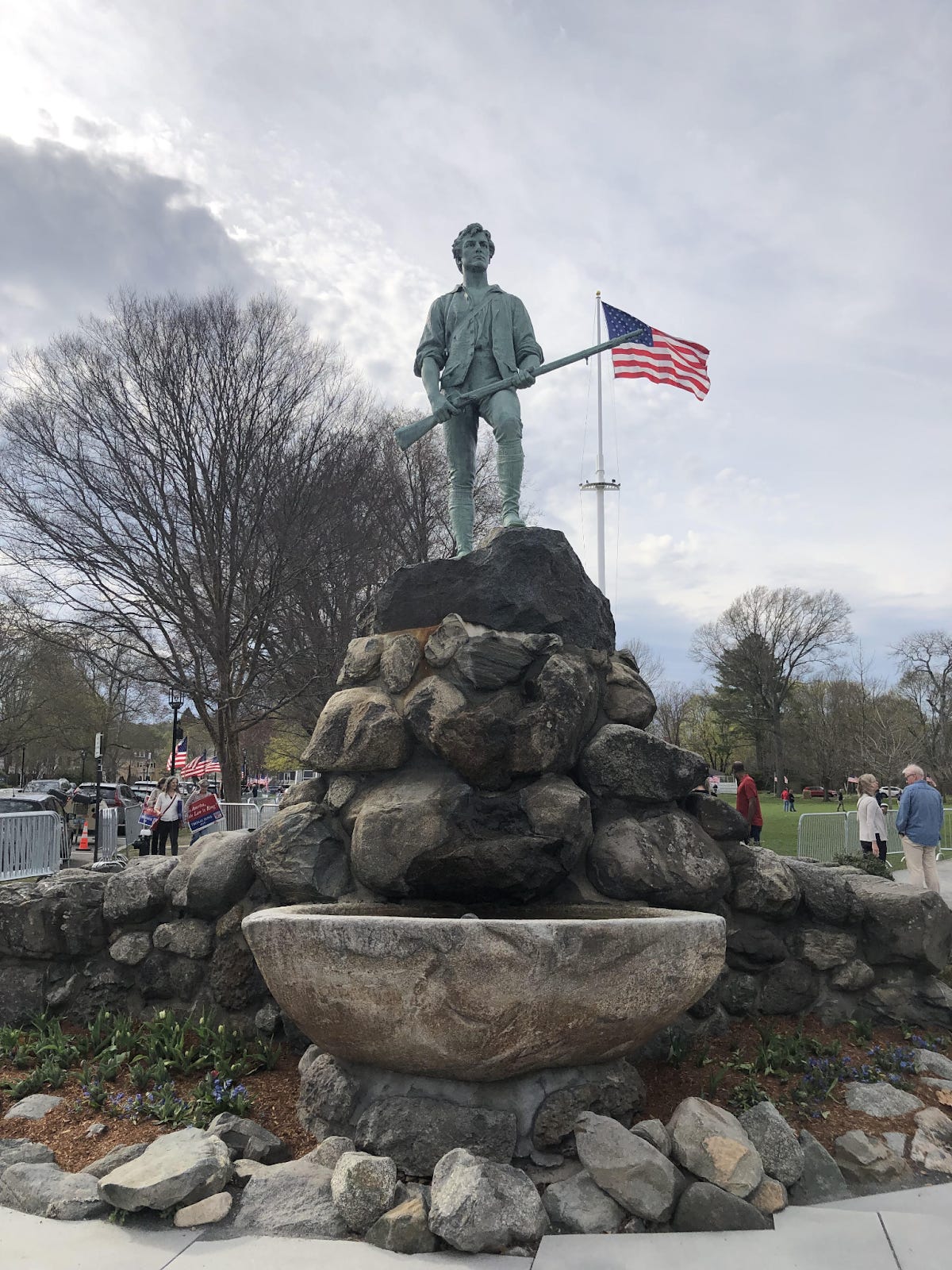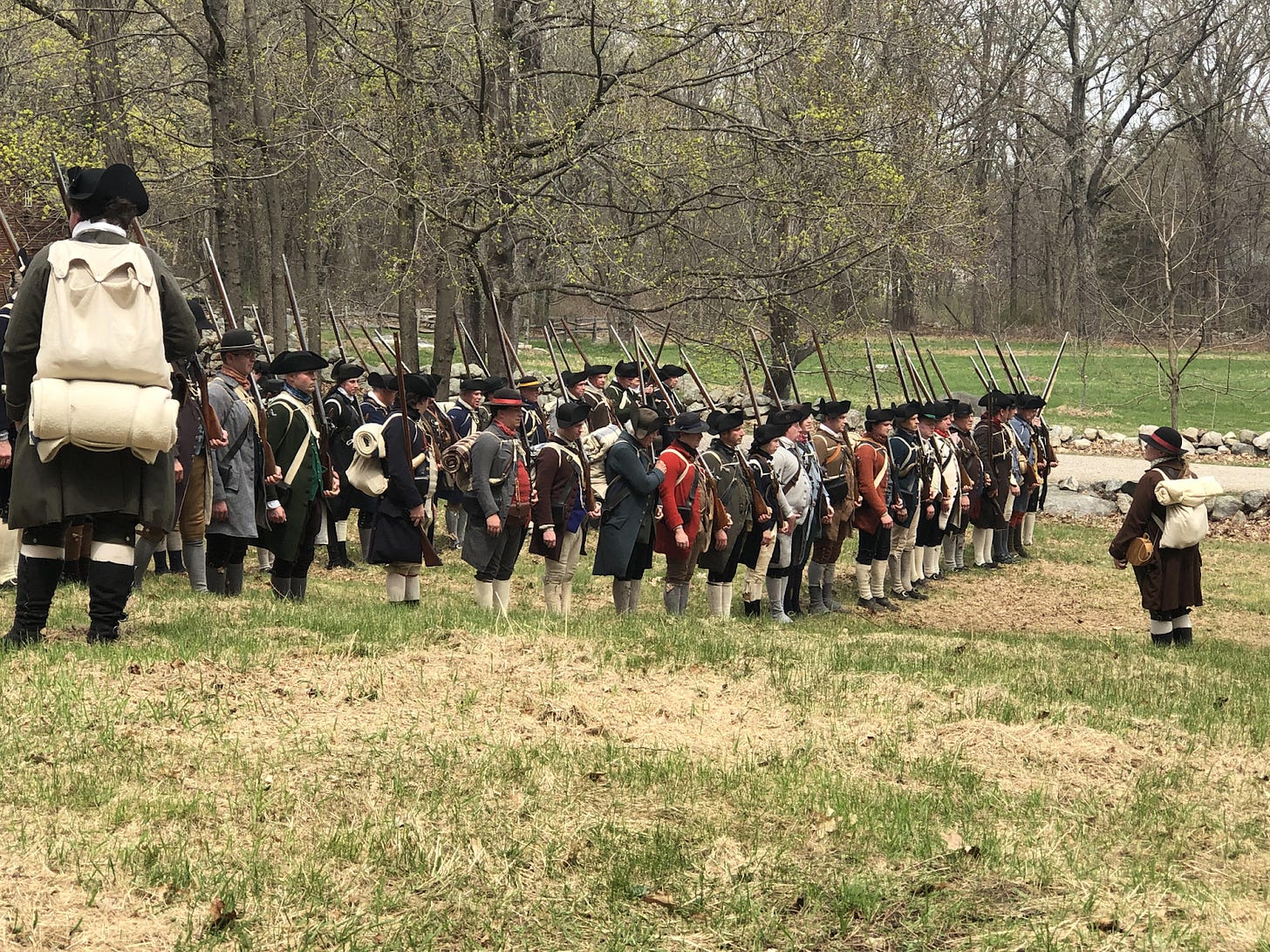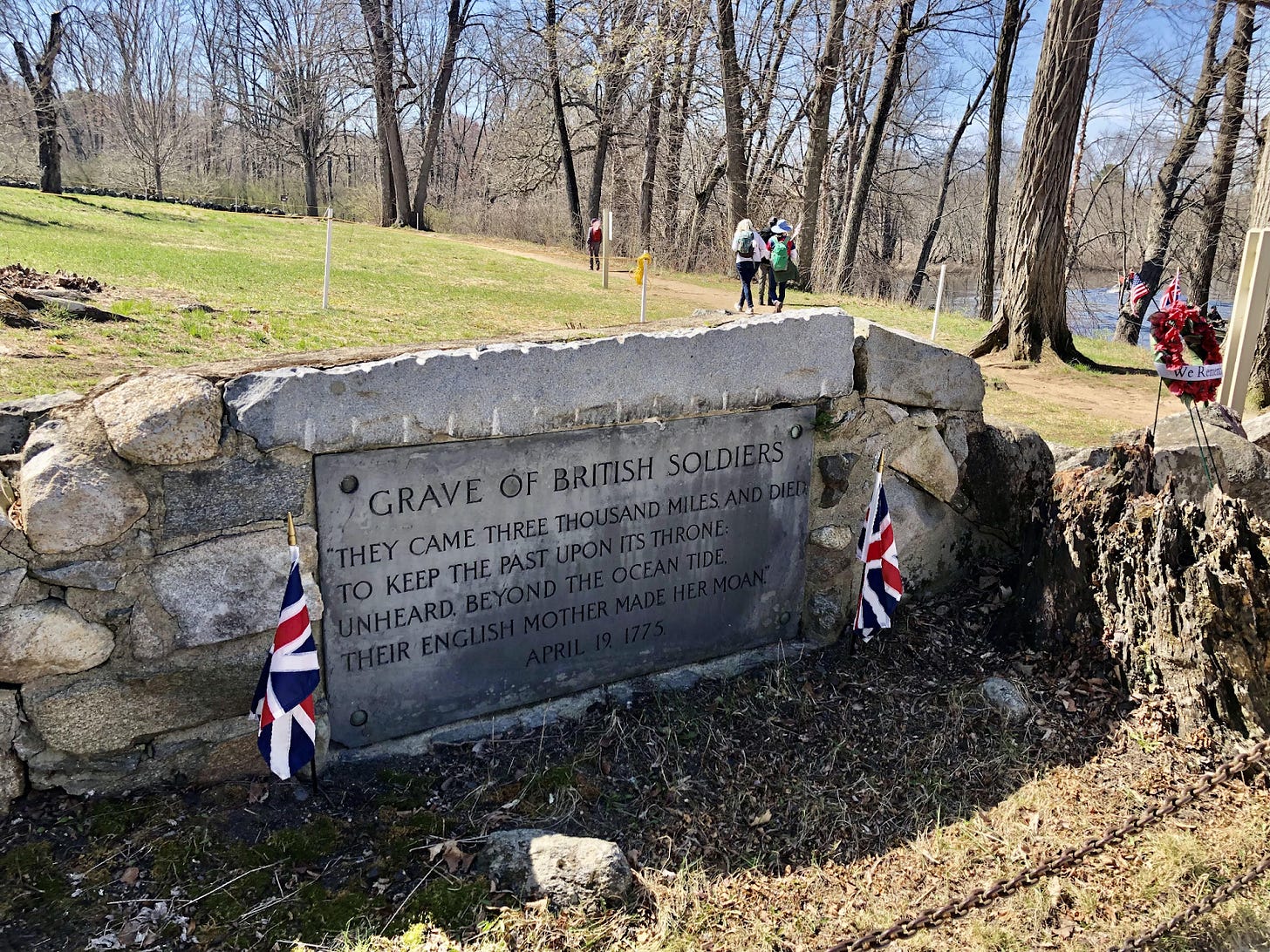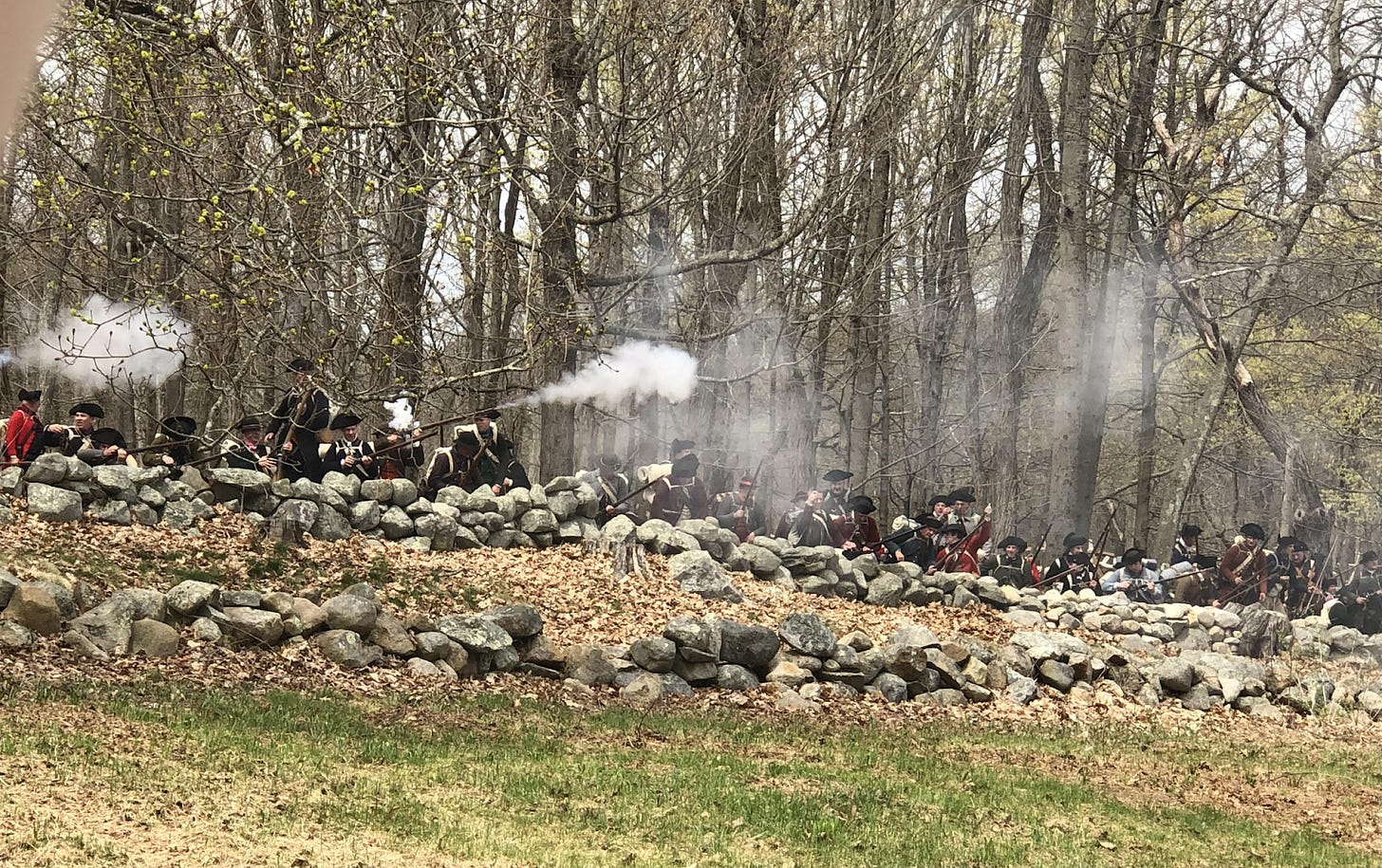Patriot Day is a national day of observance on September 11 that was created after the 2001 terrorist attack. There is another Patriots’ Day that predates the national holiday that is only observed in seven states. This Patriots’ Day is celebrated on April 19, which is fitting because that’s the anniversary of what the day honors: the Battles of Lexington and Concord—the first battles of the American Revolutionary War. Some states have shifted the date so that it falls on a Monday, but the intent remains to honor this pivotal moment in American history.
As a member of Blair County’s 250th Anniversary committee, I have probably been more in tune with the approaching Semiquincentennial celebration of the United States; thus, I decided in 2024 that I was going to travel to Lexington and Concord for the big celebration. Apparently, 100,000 other patriotic-minded folks decided the same. Here are my observations from our (my and Jen’s) weekend, which will be a combination history lesson, travel guide and personal recollection of the largest ever celebration at Minuteman National Historic Park, which includes both Lexington and Concord.
Let’s start with a little review of how we got to the opening shots of war in 1775. British settlers in Massachusetts and other New England colonies were granted the same rights of British citizens in their colonial charters. However, paper and reality are two very different things. The French and Indian War, the North American theatre of the Seven Years War, that took place from 1754 to 1763, proved to be a major financial drain on the British government, who subsequently decided the colonies should pay for their own defense. The British, who had basically ignored the colonies for 150 years except to make money from trade, suddenly reversed policy—a hands-off policy that the colonists came to expect. The Stamp Act (1765) created a tax on colonially printed goods such as newspapers and playing cards; it was the first outside tax on colonial goods. The Townshend Acts (1767) then taxed imported goods such as lead, glass, tea and paint. Both were viewed by colonists as an abuse of power and violation of the principle of taxation without representation.
By 1770, Boston had become the epicenter of resistance to these English taxes. It was not unusual to see angry protests in the streets. During one of these protests, British soldiers, fearing for their safety, opened fire and killed 5 colonists in what became known as the Boston Massacre. This increased protests until the Townshend Acts were repealed and replaced with the Tea Act. This did not placate the colonists, who loved their tea, and it led to further angst, including colonists dressing up like Native Americans and dumping that tea into the Boston Harbor on December 16, 1773. As a result, Parliament passed the Coercive (Intolerable) Acts that closed Boston Harbor and eliminated local government in hopes of ending resistance. If you are guessing that did not go over well, you are correct. Resistance increased. The First Continental Congress met and demanded rights for colonists. Colonists living in the Boston area started gathering weapons and conducting militia drills that were usually reserved for protection from Native Americans. They had hidden throughout the area around Boston enough weapons to arm 15,000 men. The British also increased their military presence, but they only controlled Boston and declared the remainder of the colony was in a state of rebellion. Armed conflict was only a matter of time.
On April 19, 1775, British General Thomas Gage, military governor of Massachusetts, ordered 700 British soldiers under the command of General Francis Smith to proceed as quickly as possible to seize and destroy any weapons and military supplies belonging to the rebels in and around Concord. Loyalist spies had informed him of stockpiles hidden there. He did not order the arrest of rebel leaders although that was in the initial orders from Great Britain. This operation was known to colonial spies for ten days, and thus they were ready to spread the word as soon as the troops moved. Due to popular lore, I think everyone likely recalls the fact that when the British troops departed, a signal would be given from Old North Church using lanterns: one if they marched the long route by land and two if by sea, taking a shortcut by boat across the Boston Harbor. I saw one of the two lanterns that flashed that night to signal they took the shortcut—one of the many remarkable artifacts housed at the Concord Museum—during our visit. The Concord Museum was recently ranked the best small town museum in America. It is a fitting honor as the museum is beautifully designed and has significant holdings related to not just the battles, but also Concord’s history and the many literary figures from the area, such as Henry David Thoreau, Ralph Waldo Emerson and Louisa May Alcott. Emerson’s home is across the street from the museum.
You are also likely to recall two riders on horseback—Paul Revere and William Dawes—galloping on two routes through the night to warn those in the area to hide their stockpiled arms and to ensure leaders had time to escape. Revere is certainly the more well-known of the two, but Dawes was also a famous member of the Sons of Liberty who personally added to the stockpile of rebel weapons by stealing two British cannon while a sentry was on duty. As Dawes and Revere galloped through the night, I would like to take a moment to end one long-standing misconception. Nobody was yelling, “The British are coming!” as that would have resulted in a state of puzzlement since everyone at the time considered themselves British. They were yelling, “The Regulars are coming,” in reference to the term used for the British soldiers.
Dawes and Revere met in Lexington where they were joined by Dr. Samuel Prescott, who was out late to meet a lady friend. Revere warned Sam Adams and John Hancock, who prudently fled the area. Not long thereafter Revere and Dawes were captured by British officers; one ordered Revere to dismount, threatening at gunpoint, "I'll blow your head off.” I share this not just because it’s language we consider to be more modern, but also to gain an idea of the amount of courage it took to undergo the ride, for the lives of the men were truly in danger. Jen and I visited the site where they were captured, which features a large plaque.
Prescott, unlike Dawes and Revere, avoided capture, and he is the one who made it all the way to Concord to sound the alarm there. Across the countryside everyone was anxiously awaiting the arrival of the British soldiers, wondering what would happen. Militiamen, nicknamed Minutemen because they would arrive at a minute’s notice, prepared their muskets and their courage to stand up to the strongest military in the world if necessary. These men were farmers and craftsmen and few had prior military experience, but they did have experience hunting and using their muskets. It's important to remember that this intrepid ride at full gallop took place after midnight on unpaved roads with no street lights or signs. I will also add there is almost always a heroic woman involved in these historic moments, usually saving the day. Revere had to row a boat across Boston Harbor to start his ride, but the old row boat he secured had oars that were very loud—so loud they would likely be heard by British ships in the harbor. Revere found a lady nearby who surrendered her petticoats to the cause: Revere wrapped them around the oars and oarlocks to mute the noise.
Approximately 80 militiamen of Lexington gathered at Buckman Tavern as additional riders were sent to surrounding communities to summon help. The tavern, as seen in the attached photo, is open and operated by the Lexington Historical Society. After waiting for several hours, some militiamen actually left, assuming it was a false alarm. Captain John Parker ordered his men to gather on the Lexington Green, a grassy common area that is still in the center of town, and was the site of one of the reenactments. Parker knew he was vastly outnumbered and the British were likely headed to Concord, so he told his men, “We will take no action unless we are molested.” Among the 70 militia members were 20 of Parker’s relatives.
Sometimes the smallest decision can completely alter the direction of history, and this is one of those cases. The lieutenant in charge of the advanced guard of the British column didn’t follow the left turn at Lexington toward Concord; instead he ordered a turn that took his troops directly onto the Lexington Green and opposite Parker’s militia. British Major John Pitcairn, who would be killed two months later at Bunker Hill, rode forward and instructed the “damned rebels” to lay down their arms and disperse. Parker, suffering from tuberculosis, ordered his men to disperse as they were outnumbered, facing three companies of British regulars, and he saw no need to sacrifice his men. A few men turned to go home but many remained, either confused by the cacophony of noise and yelling or unable to hear Parker's voice that was weakened from tuberculosis. At this moment, it happened: The Shot. The shot heard ‘round the world. To this day, nobody knows who fired that first shot. Militiamen blamed the Brits and vice versa. Some claim it was fired by one of the spectators watching the events unfold. Though countless people, from historians to ballistics experts, have espoused opinions, it remains one of history’s great mysteries.
Both sides opened fire. The militiamen and nearly 100 town spectators scattered, becoming panicked as they fled. The British, too, advanced without order and conducted a bayonet charge into the colonists—possibly feeling a sense of revenge watching them flee after years of being taunted and harangued. The British eventually regrouped after considerable time to discover that one of their men was wounded. Ten colonists were wounded and eight killed, including Prince Estabrook, a Black slave serving in the militia. The saddest story was likely Jonathan Harrington, who was fatally wounded by a musket ball and somehow crawled home, which was some distance away, and died on his doorstep. The battle, more likely a skirmish, started at 5 a.m. and ended quickly. Eight minutes of action led to eight years of war.
Meanwhile, the reorganized British fired a victory volley before continuing their march to Concord. It would be their last celebration that day.
The distance from Lexington to Concord is six and a half miles. There are trails maintained by the National Park Service between the two cities that connect many of the historic sites. We certainly explored the trail when we were there, but not with the same urgency the British had on April 19, 1775. We stopped at various sites, but there was no sense of alarm in the air for us like there was for the colonists as the Regulars approached Concord—especially when the British-led element observed 250 militiamen from Concord and Lincoln gathered in the road. Since the militiamen were still outnumbered three to one, they withdrew to Concord and the heights on the other side of the town to observe. They weren't worried about the British capturing the large stockpiles of weapons; nearly all had been moved or destroyed. It was also a fortuitous delay because the militia leaders could discuss what to do as their numbers swelled as more men arrived from nearby towns. On our first day there, we witnessed a representation of this as reenactors from Acton marched from Acton to Concord and onto the North Bridge where they fired several volleys and laid a wreath. It was a fascinating experience at the North Bridge with drums and fife providing the cadence to start our day on Friday. North Bridge is important to see when visiting this area. There is a visitor center there as well. The experience is on par with visiting the Arizona Memorial at Pearl Harbor, walking Pickett’s Charge at Gettysburg or seeing Fort McHenry in Baltimore. It’s hallowed ground and an honor to walk in the footsteps of those from 1775.
The British troops began searching for weapons and other contraband in Concord. They dumped barrels of flour and some musket balls they found into the Concord River. Most of these items were recovered after the British left since the barrels had been properly sealed. When they arrived at the property of Ephraim Jones, he refused to allow them access until they threatened to shoot him. Jones had good reason—hidden on his property were three large siege cannons. They were too heavy to be moved. The British made another fateful decision that would change the course of history. They took the caissons and carriage from the cannon as well as some tools inside the barn and set them on fire. The militiamen observing from the heights above North Bridge could only see the smoke and assumed the British were burning the town. The militiamen who had pulled back and had settled on merely observing now reformed and marched down the hill, descending upon North Bridge. History once again was about to be changed forever.
The British troops in the area, now outnumbered by the militiamen, retreated across the bridge. They numbered about two companies (200) while there were ten companies of militia from Concord and the surrounding area. As I walked this path, it was hard not to think about what was going through their minds on that April day. Many of the men on both sides had never experienced combat. The leaders of the militia units decided to form a lead column two abreast and continued to advance toward the bridge. Spring flooding forced them to stay on the road. The company from Acton I mentioned earlier was asked to be in the lead. Their commander, Captain Isaac Davis, did not hesitate, declaring, “I nor any of my men are afraid to go.” They led the way.
The order was given to all militia to load their weapons but to not fire unless fired upon. The British withdrew across the bridge but not before a few British soldiers paused to pull up the boards of the bridge to prevent its use. Already fearing the town was being burned, Major John Buttrick started to yell not to destroy their bridge. Events quickly spun out of control. The British tried to form skirmish lines when someone fired a warning shot at the approaching militia. Yes, another unknown shooter, but definitely a British soldier this time. Two other British soldiers fired, hitting the water. Chaos ensued and British soldiers in the first line opened fire, assuming the order had been given to do so although it wasn't. The first two killed were from Acton: Private Abner Hosner and Captain Isaac Davis, who was previously mentioned. Four others were wounded. Major Buttrick shouted, “Fire, for God’s sake fire!” and the muskets of the Acton militia erupted in smoke and fire. Twelve British soldiers fell, three fatally.
The British lost twelve men at North Bridge where they abandoned their wounded. The British troops again broke ranks like they did at Lexington, but this time it was to flee and reunite with their other troops that were still in Concord searching for supplies and eating lunch. Surprisingly, they paid for the food they consumed provided by colonists. Just like the colonial militia, many of these men were engaged in combat for the first time. There was a standoff for a short time as the militia watched the Regulars assemble and prepare to march the sixteen miles back to Boston. In an odd and unbelievable scene, a local man who was described as mentally ill wandered between the two armies selling cider, without fear, to soldiers on both sides.
The worst was yet to come for the British. The original British force of 700 was now in retreat to Boston and calling for reinforcements. A relief column departed Boston with an additional 1,000 British soldiers and Marines. They played the song “Yankee Doodle” to taunt local residents. They had no clue what they were marching into. Along the entire route, hundreds of militia and anyone with a musket arrived, numbering an estimated force of 4,000 men and teenagers. The entire sixteen-mile march became a gauntlet of murderous sniper fire and ambushes. It was the first offensive action by the colonists and surprised the British. It seemed like every turn, every tree line, every building, every stone wall, and every hill along the road to Boston meant gunfire for both British columns. A marker identifies the spot where the first two British soldiers were killed on the retreat, a spot near Meriam’s Corner along what is now known as Battle Road.
It was guerilla warfare at its best. The British were so frustrated they sometimes fired randomly at homes along their route and searched them for any adult male colonists. At 1:45 p.m. the remaining men of Parker’s militia who fled the Lexington Green that morning now waited hidden among the trees and behind the boulders to exact their revenge. In what became known as Parker’s Revenge, they fired on the British regulars. A recent archaeological survey identified the location of Parker’s Revenge—another cool site to visit on your trip. It was reenacted while we were there, and in a really exciting moment, as the British reenactors withdrew and minutemen advanced to push them back, the crowd erupted in cheers. It likely wasn't the same feeling of accomplishment from 1775, but it gave spectators a warm feeling of pride and one couldn't resist joining in the cheering—certainly a highlight of our weekend. Even if not visiting on a day with reenactors, it's really worth checking out Battle Road as there are other spots such as the Bloody Angle and Bloody Bluff to appreciate the sacrifice and commitment that day. It's a unique combination of both the scenic beauty of the New England countryside and historic reverence.
British casualties during the march to Boston would be far worse than they were at the Lexington and Concord engagements, numbering more than 250, including 73 killed. The Americans, as they had now become, lost 49 killed and 41 wounded. The worst fighting took place in the town of Menotomy, which is called Arlington today. The day was a surprising victory for the colonists. In fact, they paused as the Brits fled the North Bridge stunned with their success until they gained composure and pressed forward. It was an even bigger public relations victory as word spread to other colonies and the Continental Congress, which boosted everyone’s confidence and willingness to undertake the siege of British forces in Boston.
One final note, there are many good places to eat, but our favorite was Via Lago, which is just off the Lexington Green and worth a stop to enjoy a delicious meal in our great country that began its quest for independence across the street 250 years ago when that shot was heard ‘round the world. Huzzah!












I love the story of Parker’s revenge! Always been a favorite. So cool you got to see it reinacted! Great work as always Jimmy!